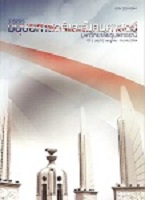การพัฒนาทักษะการคิดเชิงวิเคราะห์ของนักเรียนระดับชั้นมัธยมศึกษาปีที่ 5 เรื่อง อัตราการเกิดปฏิกิริยาเคมี โดยใช้ชุดการสอนและการจัดการเรียนรู้แบบสืบเสาะหาความรู้
Main Article Content
บทคัดย่อ
งานวิจัยครั้งนี้มีวัตถุประสงค์เพื่อ (1) พัฒนาทักษะการคิดเชิงวิเคราะห์ของนักเรียนระดับชั้นมัธยมศึกษาปีที่ 5 โดยใช้ชุดการสอนและการจัดการเรียนรู้แบบสืบเสาะหาความรู้เรื่องอัตราการเกิดปฏิกิริยาเคมี (2) ออกแบบชุดการสอน เรื่องอัตราการเกิดปฏิกิริยาเคมีให้มีประสิทธิภาพตามเกณฑ์มาตรฐาน 80/80 (3) เปรียบเทียบผลสัมฤทธิ์ทางการเรียนด้านการคิดวิเคราะห์ของนักเรียนก่อนและหลังใช้ชุดการสอนและการจัดการเรียนรู้แบบสืบเสาะหาความรู้ กลุ่มตัวอย่างที่ใช้ในการศึกษาครั้งนี้เป็นนักเรียนชั้นมัธยมศึกษาปีที่ 5/1 โรงเรียนสำโรงวิทยาคาร สังกัดสำนักงานเขตพื้นที่การศึกษาอุบลราชธานี เขต 4 ภาคเรียนที่ 1 ปีการศึกษา 2552 จำนวน 46 คน ดำเนินการโดยใช้แบบแผน The pretest - posttest Equivalent Groups Design (EGD) เครื่องมือที่ใช้ในการวิจัยประกอบด้วย ชุดการสอนจำนวน 7 ชุด และแบบทดสอบวัดผลสัมฤทธิ์ทางการเรียนด้านการคิดวิเคราะห์ ซึ่งมีค่าความยากง่ายตั้งแต่ .50 ถึง .80 ค่าอำนาจการจำแนกตั้งแต่ .36 ถึง .56 และค่าความเชื่อมั่น .91 ชุดการสอน เรื่องอัตราการเกิดปฏิกิริยาเคมีมีประสิทธิภาพ 80.39/81.04 ข้อมูลของนักเรียนเชิงสถิติที่ใช้ในการวิเคราะห์ข้อมูลได้แก่ ค่าร้อยละ ค่าเฉลี่ย ส่วนเบี่ยงเบนมาตรฐาน และการทดสอบค่า t ผลการวิจัยพบว่า นักเรียนสามารถออกแบบการทดลองด้วยตัวเอง สามารถอธิบายผลการเปลี่ยนแปลงของปัจจัยที่มีต่ออัตราการเกิดปฏิกิริยาเคมีตลอดจนสามารถพัฒนาทักษะการคิดเชิงวิเคราะห์ทางวิทยาศาสตร์ได้เป็นอย่างดี รูปแบบนี้จึงเป็นรูปแบบการเรียนการสอนที่เน้นนักเรียนเป็นศูนย์กลางมากขึ้น เมื่อมีการใช้ชุดการสอน ผลสัมฤทธิ์และทักษะการคิดเชิงวิเคราะห์นักเรียนสูงกว่าก่อนเรียนอย่างมีนัยสำคัญทางสถิติที่ระดับ .01
Enhancing Grade 11 Students’ Analytical Thinking Skills on Chemical Kinetics using Instructional Packages and Inquiry Method
This study aimed to (1) develop grade 11 students’ analytical thinking skills on chemical kinetics by using instructional packages and the inquiry method, (2) design instructional packages on chemical kinetics based on the 80/80 efficiency standard, and (3) compare the students’ achievements before and after using instructional packages and the inquiry method. The participants in this study were 46 grade 11 students who enrolled in the first semester of the 2009 academic year at Samrongwittayakan School, Ubon Ratchathani Service Area Office 4. The students’ analytical thinking skills were investigated using the pre-test/post-test Equivalent Groups Design (EGD). The research instruments consisted of 7 instructional packages and an analytical thinking test with difficulty and discrimination ranging from .50 to .80 and .36 to .56 respectively. The reliability value of the test was .91. The instructional packages on chemical kinetics had an E1/E2 efficiency of 80.39/81.04. Data were collected and analyzed using a combination of qualitative and quantitative methods. In quantitative analysis, the number of students’ responses was analyzed using statistical values including percentages, means, standard deviations, and t–test (dependent sample). The research findings showed that students were able to design experiments themselves, explain the changes of effects to chemical kinetics, and also develop good scientifically analytical thinking skills. The approach was more active studentcentered learning and teaching and was different from normal teaching of chemical kinetics. Students learning achievement and analytical thinking skills in the post-test after using the instructional packages were higher than those in the pre-test at the significant level of .01.
Article Details
บทความที่ได้รับการตีพิมพ์เป็นลิขสิทธิ์ของวารสารมนุษยศาสตร์และสังคมศาสตร์ มหาวิทยาลัยอุบลราชธานี
ข้อความที่ปรากฏในบทความแต่ละเรื่องในวารสารวิชาการเล่มนี้เป็นความคิดเห็นส่วนตัวของผู้เขียนแต่ละท่านไม่เกี่ยวข้องกับมหาวิทยาลัยอุบลราชธานี และคณาจารย์ท่านอื่นๆในมหาวิทยาลัยฯ แต่อย่างใด ความรับผิดชอบองค์ประกอบทั้งหมดของบทความแต่ละเรื่องเป็นของผู้เขียนแต่ละท่าน หากมีความผิดพลาดใดๆ ผู้เขียนแต่ละท่านจะรับผิดชอบบทความของตนเองแต่ผู้เดียว


